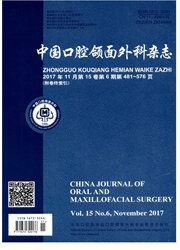

 中文摘要:
中文摘要:
目的:测定颞下颌关节(temporomandibular joint,TMJ)结构紊乱(internal derangement,ID)患者关节液中纤维蛋白的含量,并探讨其意义。方法:选取2007年12月—2008年6月期间收治的TMJ疾病患者进行临床检查,在初步诊断为结构紊乱后进行MRI检查,以获取评价关节盘情况的影像学依据,并按照Wilkes-Bronstein分期标准进行分期,将处于Ⅱ~Ⅴ期的患者纳入治疗范围,进行关节镜下盘复位固定手术,在关节镜手术前采集关节液1mL,-40℃或-70℃冰箱低温保存。采用免疫荧光激光共聚焦显微镜半定量测定纤维蛋白的含量。按照ID分期、不同年龄段、男女分组及左右侧关节分组,应用SPSS16.0软件包对所得数据进行t检验,比较不同组别之间关节液的平均荧光强度的差异。结果:所有125侧关节液的免疫荧光强度平均为4.43±3.67(0~31.68)。ID各期关节液的平均荧光强度Ⅱ期为2.38±1.17,Ⅲ期为4.68±3.98,Ⅳ期为4.80±2.80,Ⅴ期为3.58±2.64,其中Ⅱ期与Ⅲ期(P=0.0065〈0.05)、Ⅳ期(P=0.0207〈0.05)之间有显著差异。男性患者关节液的荧光强度平均为4.05±2.70,女性患者关节液的荧光强度平均为5.57±4.71,男女之间有显著差异(P〈0.05)。左侧TMJ关节液的平均荧光强度为4.37±3.04,右侧平均为5.97±5.20,两者有显著差异(P〈0.05)。10~19岁为4.55±2.45,20~29岁为4.56±3.39,30~39岁为2.60±1.12,40岁以上为5.68±6.71,其中第1和第3组,第2和第3组及第3和第4组年龄段之间有显著差异。结论:关节液的平均荧光强度随着ID分期增高,呈现升高趋势,为IA形成假说提供了理论支持。
 英文摘要:
英文摘要:
PURPOSE: To analyze the synovial fluid,and explore the significance of fibrin during the formation of intra-articular adhesion(IA).METHODS:Arthroscopic disc repositioning and suturing was performed on patients with temporomandibular joint(TMJ) internal derangement(ID) ranging from stage Ⅱ to Ⅴ who visited the TMJ clinic at the Ninth People’s Hospital,Shanghai JiaoTong University School of Medicine,between Dec.27,2007 and Jun.16,2008.The patients’ ID stages were classified based on the criteria of Wilkes & Bronstein’s classification.125 samples of synovial fluids were collected before arthroscopic surgery and stored in cold environment.According to the fluorescence intensity of each sample,and the immunofluorescence confocal laser microscopic semi-quantitative analysis was used to determinate the content of fibrin.Student’s t test was performed using SPSS16.0 software package,to compare the difference of the average fluorescence intensity of joint fluid in different groups(ID stage,different age,different sex and different joints).RESULTS:There was statistically significant difference in the synovial fluid immune fluorescence intensity in different sex and age group.The average synovial fluid immune fluorescence intensity of all 125 samples was 4.43±3.67(0-31.68).The average immune fluorescence intensity of each stage was stage Ⅱ: 2.38±1.17,stage Ⅲ: 4.68±3.98,stage Ⅳ: 4.80±2.80 and stage Ⅴ: 3.58±2.64.There was significant difference between the results of stage Ⅱ and stage Ⅲ(P=0.0065〈0.05),and there was significant difference between the results of stage Ⅱ and stage Ⅳ(P=0.0207〈0.05).The average immune fluorescence intensity of the male group was 4.05±2.70 and the female group was 5.57±4.71.There was significant difference between the results of male group and female group.The average immune fluorescence intensity of the synovial fluid of left TMJ was 4.37±3.04 and the right TMJ was 5.97±5.20.There was significant difference betwee
 同期刊论文项目
同期刊论文项目
 同项目期刊论文
同项目期刊论文
 期刊信息
期刊信息
